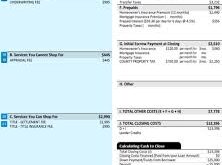Mortgage Payment Breakdown: Your Monthly Costs. When buying a home, understanding the mortgage payment breakdown is crucial. Many homeowners assume their monthly payments only cover the loan principal and interest, but they often include additional costs like taxes, insurance, and other fees. This guide will explain how mortgage payments are structured, the components involved, and how you can manage these expenses effectively.
What is a Mortgage Payment?
A mortgage payment is the amount a homeowner pays each month toward repaying a home loan. This payment ensures that the borrower stays on track with their mortgage terms and avoids penalties or foreclosure.
Mortgage Payment Breakdown
A typical mortgage payment consists of four main components, often abbreviated as PITI:
1. Principal
The principal is the portion of your payment that reduces the original loan amount. In the early years of the mortgage, a smaller percentage of your payment goes toward the principal, while more goes toward interest.
2. Interest
The interest is the lender’s charge for allowing you to borrow money. The amount of interest depends on the loan balance and the interest rate. Over time, as the principal decreases, interest payments also decline.
3. Taxes (Property Taxes)
Most mortgage lenders collect property taxes as part of the monthly payment and hold them in an escrow account. These taxes are determined by your local government and vary depending on property value and location.
4. Insurance
Homeowners must also pay for homeowners insurance and, in some cases, private mortgage insurance (PMI). These protect the lender and borrower from financial risks such as damage, theft, or default.
Additional Mortgage Costs
Apart from PITI, some homeowners might encounter additional expenses, such as:
- Mortgage Insurance: If you put down less than 20%, you may need to pay for PMI.
- HOA Fees: If you live in a neighborhood with a homeowners association, you’ll have to pay HOA fees.
- Extra Loan Fees: Some loans have special costs, such as VA funding fees or FHA mortgage insurance premiums.
How to Calculate Your Mortgage Payment
You can estimate your monthly mortgage payment using this formula:
Where:
- M = Monthly payment
- P = Loan principal amount
- r = Monthly interest rate (annual rate/12)
- n = Number of months in the loan term
Alternatively, you can use an online mortgage calculator to simplify the process.
How to Lower Your Mortgage Payment
Reducing your mortgage payments can free up money for other expenses. Here are some strategies:
- Refinance to a Lower Interest Rate: A lower rate reduces monthly costs.
- Make a Larger Down Payment: Reduces the loan amount and eliminates PMI.
- Extend Your Loan Term: A 30-year mortgage has lower monthly payments than a 15-year loan.
- Appeal Your Property Tax Assessment: If your home’s value is overestimated, you may qualify for a tax reduction.
- Cancel Private Mortgage Insurance (PMI): Once you reach 20% equity, you can remove PMI.
10 Tips for Managing Mortgage Payments
- Set up automatic payments to avoid late fees.
- Make biweekly payments to reduce interest faster.
- Avoid interest-only loans unless necessary.
- Pay extra toward principal whenever possible.
- Shop around for homeowners insurance to find the best rate.
- Consider an escrow waiver if you’re comfortable managing taxes yourself.
- Keep an eye on mortgage rates and refinance when beneficial.
- Avoid taking out new loans that can impact your credit score.
- If struggling, contact your lender for loan modification options.
- Stay updated on property tax changes that could affect your payment.
10 Frequently Asked Questions (FAQs)
1. What happens if I miss a mortgage payment?
Missing a payment can result in late fees and negatively impact your credit score. If payments are missed repeatedly, foreclosure could occur.
2. Can I pay my mortgage off early?
Yes, but check for prepayment penalties before making extra payments.
3. How does escrow work in a mortgage?
Lenders collect property taxes and insurance in an escrow account, then pay them on your behalf.
4. Why did my mortgage payment increase?
Your payment may increase due to rising property taxes, homeowners insurance costs, or adjustable interest rates.
5. What’s the difference between fixed-rate and adjustable-rate mortgages?
Fixed-rate loans have the same interest rate for the loan’s life, while adjustable-rate mortgages (ARMs) change over time.
6. Can I change my mortgage payment date?
Some lenders allow flexibility, but it depends on the terms of your loan.
7. How do I know if I need private mortgage insurance (PMI)?
PMI is required if you put down less than 20% on a conventional loan.
8. What factors determine my mortgage interest rate?
Your credit score, loan amount, down payment, and market conditions affect your rate.
9. Can I remove property taxes from my mortgage payment?
Only if your lender allows you to pay property taxes separately.
10. How can I dispute a high property tax bill?
You can file an appeal with your local tax assessor’s office if you believe your home value is overestimated.
Conclusion
Understanding your mortgage payment breakdown helps you manage homeownership costs effectively. By knowing how principal, interest, taxes, and insurance work, you can budget accurately and avoid unexpected expenses.
Whether you’re a first-time homebuyer or a seasoned homeowner, staying informed about mortgage payments empowers you to make sound financial decisions. If you’re looking for ways to reduce costs, consider refinancing, paying extra toward principal, or reviewing your property tax assessment. With smart planning, you can achieve long-term financial stability while managing your home loan efficiently.
 mortgage.kbk.news
mortgage.kbk.news
